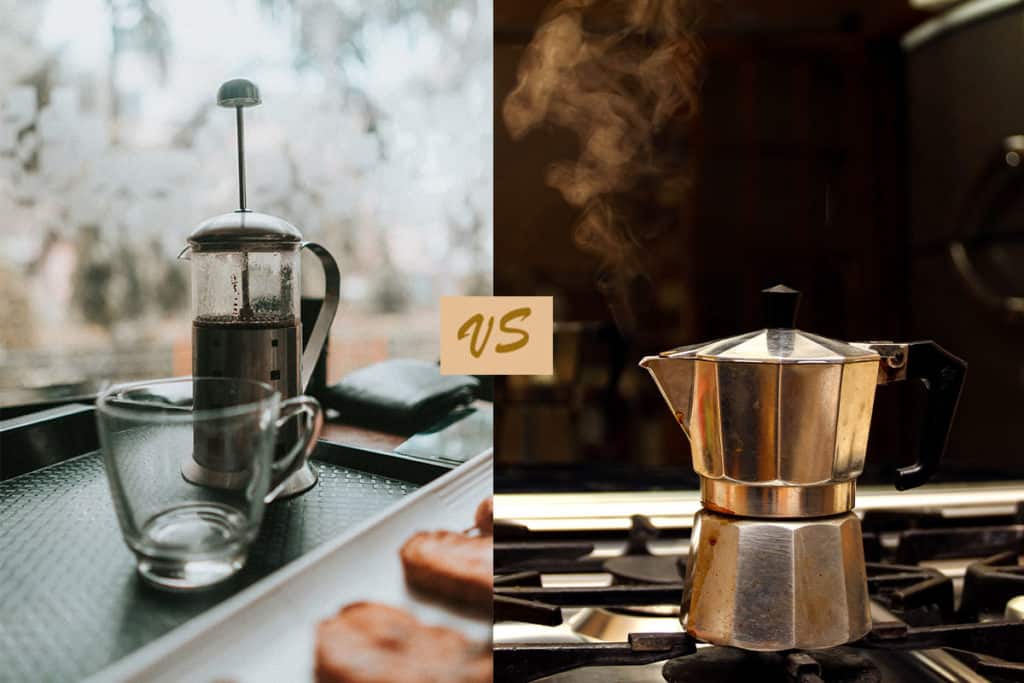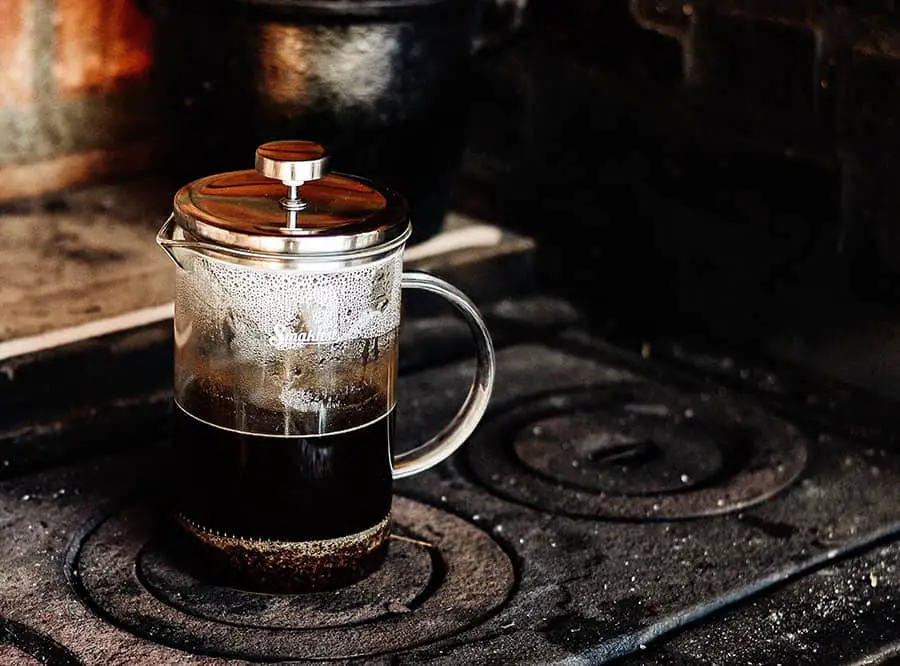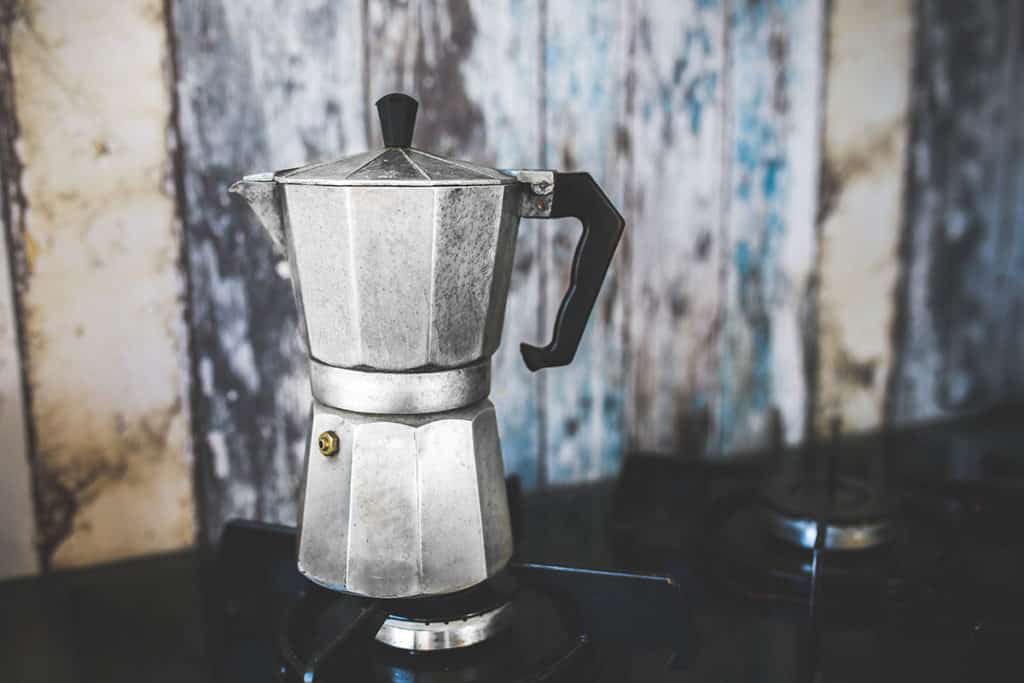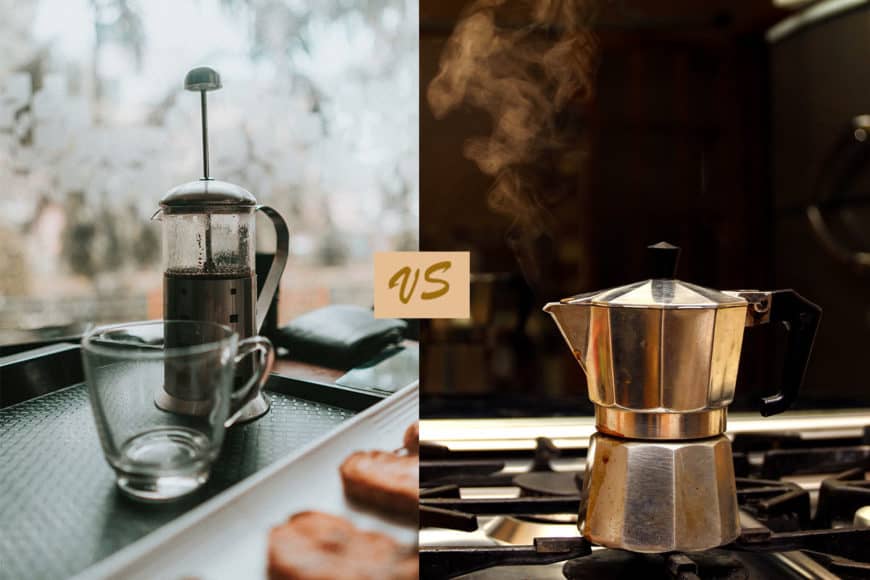
The difference between a French Press and a Moka Pot is how the water comes in contact with the coffee, the grind size, the amount of coffee made and the ultimate taste of the coffee.
Lets explore the differences between a french press and a moka pot. Even though they are both manual brewing methods and both make a great cup of coffee, there are significant differences between them.
At the end of the day we all have our preferences when it comes to our cup of coffee, so let’s have a look at their differences between the Moka Pot and French Press in order to find out which is the one for you.
What is a French Press?
If you are wondering which brewing method was invented first then you’ll be interested to know that the french press won the race. It was patented in 1852 by the French duo Mayer and Delforge, hence its name. However, there are quite a few names for it such as Press Pot, Plunger, Cafetiére and Chambord.
Actually, the first version of the french press did not include a seal. It wasn’t until 1929 when two Italians, Attilio Calimani and Giulio Moneta crafted a design that included a seal and allowed for more efficient pressing.
However, the most popular design that exists to this day was patented by Faliero Bondanini in 1958 and was sold by a French company under the name ‘Chambord’. This company was then sold to the Danish company Bodum Holding in 1991. Bodum kept the design and sells the popular french press to this day.
What is a Moka Pot?
The moka pot on the other hand was invented in 1933 by Alfonso Bialetti but it wasn’t until the late 1940s that it started gaining popularity. Back then the traditional espresso machines were very big and mostly used for commercial purposes.
As a result, the rise of coffee culture during the 1950s saw the moka pot enter every household since it offered a simple and quick way to brew a strong cup of coffee.
Its reputation as a stovetop espresso maker derives from the fact that it’s the closest thing to an espresso machine in comparison to every other manual brewing method.
It also owes its name to the city of Mocha, located in Yemen, a significant port for the country’s coffee export to Europe. The Bialetti Industries continue to manufacture the moka pot to this day.
French Press Vs Moka Pot
As mentioned above, the main difference between a french press and a moka pot is the process by which the water comes in contact with the coffee grounds. This distinction between them is what creates a different flavor in your cup even though you might be using the same coffee beans.
Apart from that there are other aspects that differ while brewing each one, such as the grind setting, the coffee to water ratio and the overall brew time.
French Press

The most common french press size yields 3 cups of coffee by using a coffee to water ratio of 1:16, that is 27g of coffee for 430ml of water. Make sure to add some extra water for preheating.
To start brewing with a french press first you will need to heat your water, while being careful not to boil it. Preheat the french press and your cups with the water and measure 27g of coffee beans.
Then grind your beans using a coarse grind setting. The reason you grind coarse is because when the grounds are immersed in the water they have the chance to extract for longer, so in order to avoid over-extracting your coffee, a coarser grind setting is advised. This is because it slows down the extraction process by making the coffee grounds more flat.
Following the grind of your coffee beans, add them to the preheated french press and shake it gently to even them out. Start your timer and add half of the water. After about half a minute, break up the crust of the coffee grounds with a stirrer or a spoon so that all the grounds are mixed with the water.
Add the rest of your water and place the lid on top without pressing down. Leave it aside to brew until your timer reaches 4 minutes. Slowly press the lid all the way down and serve your coffee immediately. Letting the brew in the french press for too long will result in over-extraction and bitter, burnt-like flavor.
Moka Pot

Even though brewing a moka pot is as close as you can get to an espresso, the difference in the pressure volume is significant. The moka pot uses only 1-2 bars of pressure in contrast to a coffee machine which uses 8-10 bars.
Nevertheless, you can easily brew a strong cup of coffee at home with a moka pot. Moka pots come in a few different sizes including a 1-cup, 3-cup, 6-cup, 9-cup and a 12-cup. The idea is that 1-cup will yield about 1 shot of coffee, a 2-cup will yield 2 shots and so on.
Whichever size you use, the ideal coffee to water ratio is 1:7, for a 2-cup moka pot that is 8g of coffee for 60ml of water.
Like with a french press the first thing you need to do is to heat your water. Then grind your beans using a fine to medium-fine setting. This is because a moka pot is a brew method with a short contact time between the coffee grounds and the water.
By grinding fine you will help increase the pressure of the brew and extract more flavor. Once you grind your coffee beans, add the grounds in the filter basket and even them out using a knife.
Fill the bottom vessel with preheated water until you reach the bottom of the release valve. Place the filter basket on top and assemble the moka pot by screwing the upper chamber on top. At this point you need to make sure that there are no grounds stuck between the basket and the upper chamber as this might prevent it from sealing properly.
Place the moka pot on your stove and set it on medium to low heat. Stovetops differ so you need to figure out which temperature is best for your moka pot. If you notice that it’s spurting then the heat is too high. It’s also advisable that you place it on the edge of the stovetop so the handle doesn’t get too hot.
Eventually the coffee will start pouring in the upper chamber. Make sure you take it off the stovetop when the coffee is nearly all the way up to the spout and place the bottom in cold water. This will stop the extraction straight away otherwise your brew might taste bitter. Serve your coffee immediately.
Flavor Profile
As you can see both the moka pot and the french press are easy to use and if done right, they make a delicious cup of coffee. However, each one will result in very different flavor and mouthfeel.
Since the idea of the moka pot is to give you a concentrated shot of espresso, your cup of coffee will be sharp and strong with a creamy mouthfeel. This is ideal for people who are looking for a quick shot of coffee without having to buy an espresso machine.
On the other hand, the french press is designed to brew a rich and heavy cup of coffee that allows more room for flavor and aroma. Since it yields a higher quantity of coffee, it is more ideal for anyone who favors sipping on a cup of coffee throughout their day rather than drinking a quick shot.
Price
Whichever method you think is right for you, their price range is not much different. Whether you are going for the classic 3-cup french press by Bodum or the classic 2-cup moka pot by Bialetti you are looking at spending around 15-20 USD.
Depending on capacity and style the price can go all the way up to 90 USD. There are of course other brands out there so make sure to do your research before you decide.
Final Thoughts
The aim of this article was to compare two coffee brewing methods, the french press with the moka pot. It is evident that their key differences lie in the way they are designed to brew; the french press uses immersion while the moka pot uses pressure. Immersion calls for more water and a coarser grind setting while pressure needs less water and finer coffee grounds.
All these factors affect the flavor of the final brew, which differs a lot. However, even though they were designed during different times and for different purposes, they both changed the way we drink coffee and are, to this day, reliable brewing methods that you can find in many households.

